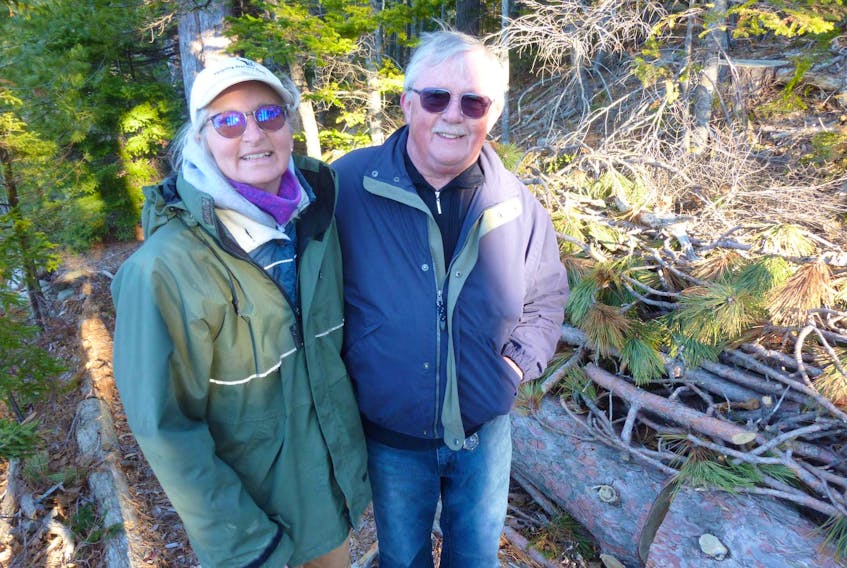“My wish is to stay always like this, living quietly in a corner of nature.” – Claude Monet
Tim and Anne Freeman must have imagined Monet’s idyllic wish when they fell in love with, then purchased, an eight-acre parcel of land along the LaHave River in 2002.
Following the construction of their comfortable waterfront home in 2008, the Freemans set out to landscape the property, determined not to leave a large footprint on Mother Nature’s handiwork.
The former Ontario residents were also looking for an eco-responsible solution to mitigate the persistent erosion eating away at much of the 1,200 feet of picturesque shoreline.
The Freemans are not alone in their shoreline worries. It appears Nova Scotians — 70 per cent of whom reside in coastal communities — have reason to be concerned about the impacts of climate change, both now and in the relatively near future.
A recent Environment and Climate Change Canada report revealed that Canada’s Ocean Playground will have to contend with ever-rising sea levels, resulting in storm surges, coastal erosion and flooding.
The Freemans turned to Rosmarie Lohnes, who they heard was somewhat of a ground-breaker in the natural remediation of shorelines, effectively helping owners of waterfront properties to protect their investments by creating a living shoreline, incorporating logs, branches and live plant material.
Lohnes is the owner of Helping Nature Heal, a Bridgewater company that has installed shoreline protection and upland preservation and rehabilitation along the South Shore for more than 15 years.
Her important work has not gone unnoticed. Five years ago, Lohnes was presented with a prestigious Coastal Zone Canada HB Nicholls Award in recognition of her significant contribution to Canadian coastal zone protection and restoration.
The National Science and Engineering Research Council of Canada has also provided support.
“My work has fundamental importance because we are located in the Acadian forest region where alder, red oak, maple, white and black spruce are all being cut faster than they are growing. The Acadian forest is at risk,” said Lohnes.
“We specialize in native plants and we use some heritage species in our work. We are not only preserving the Acadian forest but we are encouraging and regenerating it.”
Lohnes said she has been planting shrubs and grasses along the Freeman property shoreline, and adding layers of decomposing biomass such as logs, branches, leaves and garden clippings.
Over time all this material creates a decomposing layer that helps feed the plants, and the plants’ tenacious root systems and root-to-root connection combine to bind the soil and hold plants in place.
“This helps to slow erosion caused by high water levels. We can’t stop erosion — no one is better than the power of Mother Nature — so the least we can do is slow its progress,” said Lohnes.
“Just above the waterline we have been planting little trees, creating an under-storey layer that mitigates the damaging impacts of heavy rain and storm surges,” she said.
Meanwhile, the rest of the densely wooded property has been restored as a natural and serene wonderland, complete with walking trails, seating, and a serenity-inspiring labyrinth.
Even the septic field is beautiful, having been transformed into a 6,000-square-foot meadow teeming with native wildflowers whose textures and vibrant colours attract a variety of birds, butterflies and bees.
No natural material has been removed from the property. It is either left to decay where it falls or is moved to another location where it serves a useful purpose in the forest’s regeneration.
“The more deadwood you leave in the forest, the greater the health of that forest,” said Lohnes.
There is no lawn mower to be found on the Freeman property. Mulches and natural ground covers are used, eliminating mowing and fossil fuels needed to run mowing and edge-trimming equipment.
The two kilometres of trails — River Loop, Hemlock Way, North Ridge and ’Lil Brook — are constructed of hickory wood chips. By placing a new layer of chips every few years, the lower layers feed the forest system and together with the new layers relieve the compaction from footsteps.
“It’s great for folks who like to do a lot of walking because the soft, spongy layer of chips is easier on the knees and feet. It takes about 40 minutes to walk all the trails,” said Lohnes.
“The trails are also permeable, absorbing rain and preventing over-land flow of water.”
Tim Freeman said he and Anne are fond of the labyrinth Lohnes built beside their house. The labyrinth goes in circles and ends up in a special spot in the woods where a sitting area is located.
“It takes 10 minutes to walk in. Unlike a maze, which is designed as a place to lose yourself, a labyrinth is a place where you can find yourself. You walk slowly and meditate.”
Freeman said during the past 10 years Lohnes and her crew have planted 3,000 trees on the property, and built a pond, which is now home to ducks, frogs, turtles and other native species.

Scattered throughout the property are whimsical iron sculptures crafted by Freeman, including a 500-lb., life-size Bruce the Moose, fashioned by welding together found iron objects.
Lohnes and one or two workers continue to maintain the Upper LaHave property once a week.
“Rosmarie is skilled at bringing a property back to nature. We have worked closely together for a decade, and Anne and I enjoy the relationship we have with Rosmarie and her staff,” said Freeman.
Helping Nature Heal employs about 20 workers, male and female, whose ages range from late teens to mid 50s. Many are high school, college and university students.
Lohnes said machines are rarely used on her jobs. Everything is done by hand and wheelbarrow.
“We believe in hiring humans, not machines. It gives the youth of our community a really good experience of learning how to be hard-working, ethical people. They learn to rely on each other.”
According to Freeman, every garden club in Nova Scotia has visited their unique property.









